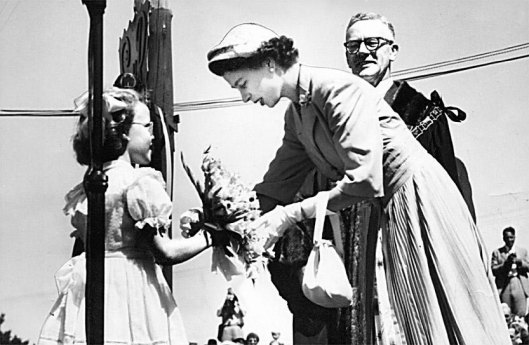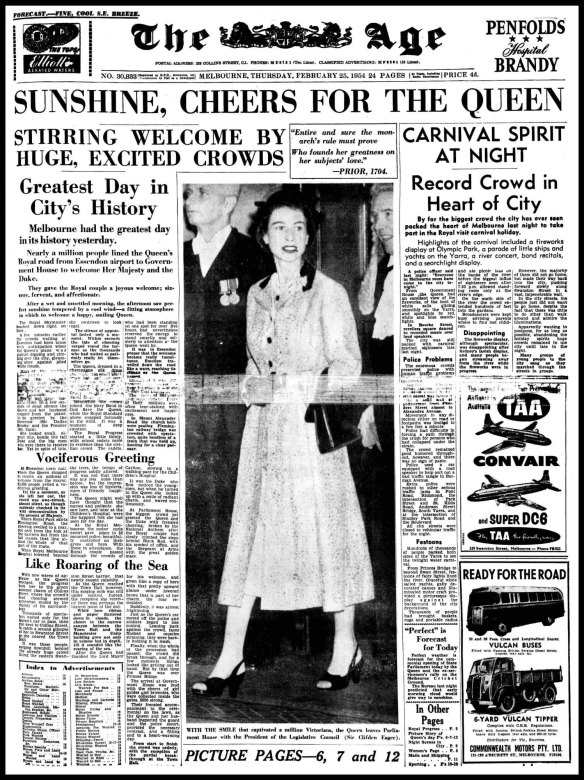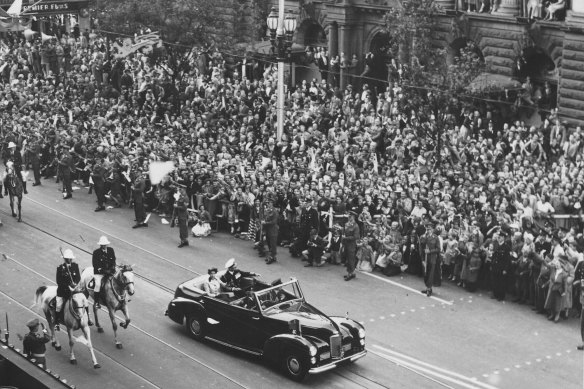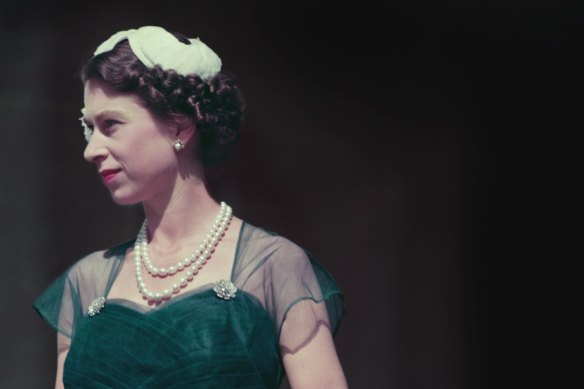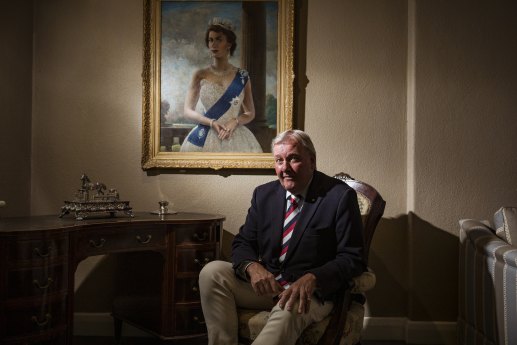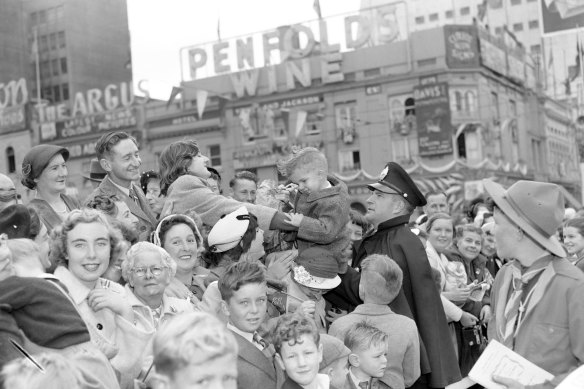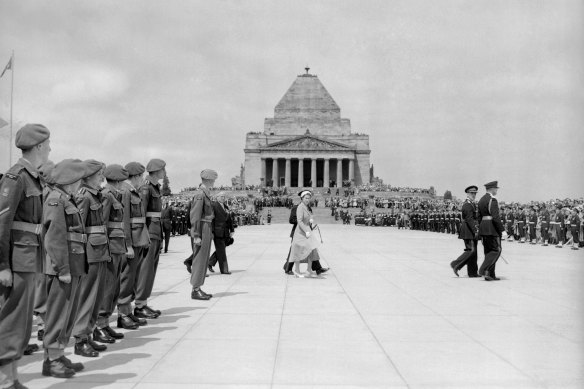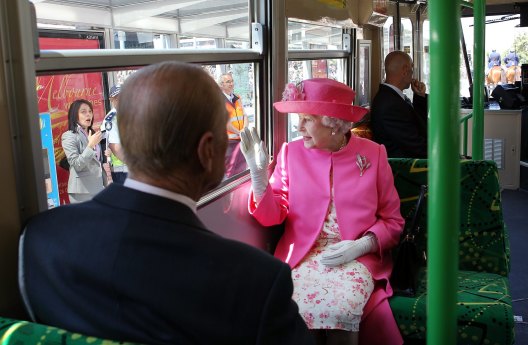Between Shepparton and Mooroopna in Victoria’s Goulburn Valley, a road winds its way through a floodplain covered with mighty river red gums.
The area is known locally as The Flats, and it was here many Yorta Yorta people made their home after walking off the station at Cummeragunja, on the NSW side of the border, in 1939, in the first mass strike of Aboriginal people in Australia.
Queen Elizabeth accepting a posy from Elizabeth Redman during her visit to Shepparton in 1954.Credit:The Age
Conditions at The Flats were basic. Yorta Yorta elder Uncle Ruben Baksh, who conducts walking history and cultural tours of the area, says there was no running water or electricity. “People got water out of the Goulburn with a pulley and a bucket.”
It was also here that a royal visit – a passing meeting between two worlds – would change everything.
In 1954, a young Queen Elizabeth embarked on her much-anticipated tour of Australia, visiting 57 towns and cities in 58 days, including 19 in the state named for her great-great-grandmother, the late Queen Victoria.
Both Shepparton and Mooroopna were on the itinerary, but someone – whose name is now lost to history – decided the sight of First Nations people, displaced from their homelands and making a new home in this sacred place on the banks of the Goulburn River, would be too much for the graceful young queen.
The front page of The Age on February 25, 1954.Credit:The Age
“They hung up hessian bags so the Queen couldn’t see the Aboriginal people down there,” Uncle Ruben recounts.
But the Queen would not have the wool pulled over her eyes so easily. Once her travelling party had reached the last bridge on the Mooroopna side, she met with several Yorta Yorta elders, who explained the living conditions they were forced to endure.
“She must have spoken to the council there and so they gave them the land at Rumbalara and built concrete homes for them,” Uncle Ruben says.
Huge crowds gathered to watch the Queen and Prince Philip in Swanston Street during the 1954 royal visit to Australia.Credit:Age Archives
The sheer scale of the 1954 tour, which came two years before the introduction of television in Australia, is difficult to imagine today.
The day after her majesty’s first appearance in Melbourne, the front page of The Age described the royal visit as the “Greatest Day in [the] City’s History”.
The newspaper reported that almost 1 million people had turned out to line the roads between Essendon Airport and Government House to catch a glimpse of Elizabeth II, then just two years into her 70-year reign.
People brought wooden crates upon which to stand and hawkers sold cardboard periscopes. It was the first time a reigning monarch had visited Australia, at a time when Federation was still within living memory.
The crowd in Melbourne, the paper trumpeted, sounded “Like [the] Roaring of the Sea”.
“With new waves of applause as the Queen emerged, the progress took her to the green summer charm of Collins Street, where the crowd’s loud cheering seemed somewhat muted by the dignity of the surroundings,” it reported.
“While torn ribbon and paper fluttered down in clouds, the cheers in the narrow canyon between the Town Hall and the Manchester Unity building grew not only in volume but in depth, till it sounded like the roaring of the sea.”
Hawthorn couple Fran and Mal Faul, now aged 80 and 77, still recall seeing her majesty during that tour. Like so many other Australians, they consider themselves republicans but still hold great respect for the Queen.
“As a young child I sat out with my mother waiting for the Queen to come to Government House just to get the glimpse of her,” Mal remembers. “It was like a miracle appearing from so far away.”
Queen Elizabeth II on the balcony of Government House, Melbourne, during her tour of Australia in 1954.Credit:Fox Photos/Hulton Archive/Getty Images
Historian and writer Robyn Annear argues the 1954 visit served as a form of validation for many people in a country that still considered itself to be part of a British motherland.
“Victorians felt so remote from their home country and they still thought of it as home, by and large, even if they had been born here,” she says.
“The Queen was the symbol of that place and of that power and Victorians really sought some acknowledgement that the royal family and the Queen knew that they existed and valued this place as subjects of hers – as valued subjects.”
During her 16 trips to Australia, most recently in 2011, Elizabeth touched the lives of many. But it appears this country also grew to become close to her heart.
Constitutional monarchist Jason Ronald at home with a portrait of the Queen.Credit:Chris Hopkins
Jason Ronald, the Australian chairman of the Royal Over-Seas League, has been fortunate to meet the Queen several times.
He believes her majesty’s affection for Australia was sparked by the extensive 1954 tour, conducted with Prince Philip, when the royal couple traversed the country by plane, train, ship and car over eight weeks.
“The extent of the areas they covered is extraordinary. And I think Australia grew on her as she saw more of it and met more of the people, and I think she liked that down-to-earth nature of Australians.
“I think we respected her also for the leadership that she gave to us and for the way she fulfilled her role as our constitutional monarch.”
So keen was three-year-old Geoffrey Cowie, of Wangaratta, Victoria, to see the Queen in Melbourne on February 28, 1954, that he crawled away from his parents through the crowd to a point in front of the barricade. But First Constable G. Walker thought young Geoffrey would be better with his mother.Credit:Fairfax Photographic
Many Melburnians continue to hold memories of meeting Queen Elizabeth and of her wry wit.
A chef, who described himself only as Keith, called into 3AW radio on Friday morning to recall how he had cooked for the Queen and other dignitaries at an event marking the opening of the 2006 Commonwealth Games.
The kitchen served King George Whiting, to which her majesty quipped: “It’s not often one gets to eat a fish named after one’s grandfather.”
Perhaps Queen Elizabeth’s most crowning achievement – among her Australian subjects – was her contribution to the ubiquity of inspect repellant Aeroguard.
The Queen at the Shrine of Remembrance in Melbourne in 1954.Credit:Fairfax Photographic
Heather Forbes-McKeon told how, in 2011, she and her husband Simon McKeon – then Australian of the Year – met the Queen at a function.
McKeon regaled her majesty with the story about how, during her 1963 tour, Queen Elizabeth had been “harangued by flies” while playing golf. At the time, CSIRO was in the process of developing Aerogard (which they later sold to Reckitt and Colman.) CSIRO offered their newly developed personal insect repellant to her to trial and it was a success – the Queen was able to play unhindered.
Forbes-McKeon says the Queen didn’t seem to recall the moment, “but she seemed to really enjoy Simon’s tale and laughed so much I could see all of her back teeth!”
“It was all over too fast; she was whisked away to the next person. I felt I had been to the moon and back. She was incredibly genuine in her warmth and sense of fun. I felt I had finally met a great aunt whom I’d heard about all my life.”
Queen Elizabeth II and the Duke of Edinburgh on a Melbourne tram in 2011.Credit:Fairfax Archives
During the same tour, which was Queen Elizabeth and the Duke of Edinburgh’s final visit to Australia, the royal couple took a ride on a Z3-Class tram through Melbourne’s CBD. In honour of the pair’s visit the exterior was transformed with a red, white and blue colour scheme; inside it was refurbished and restored.
“The monarch may be more used to travelling in a chauffeur-driven state Bentley or Rolls-Royce, but she appeared at home on public transport,” The Age quipped at the time.
“Like any other passenger, the Queen had to pay her way, although her Australian equerry, Commander Andrew Willis, had the job of buying her ticket. They used a myki – a pre-paid travel card – but it is not known if they chose the two-hour zone-one fare costing $3.80 or opted for the cheaper $2.80 dollar pensioner discount ticket.”
A journey fit for a queen of the people, who captured Victoria’s heart.
With Madeleine Heffernan, Nicole Precel and Sophie Aubrey
The Morning Edition newsletter is our guide to the day’s most important and interesting stories, analysis and insights. Sign up here.
Most Viewed in National
From our partners
Source: Read Full Article
